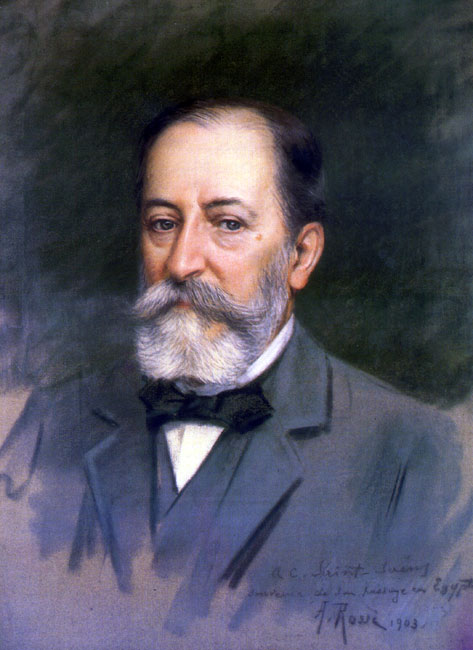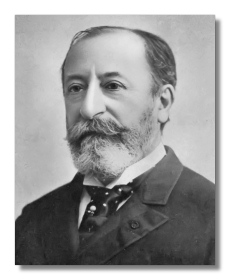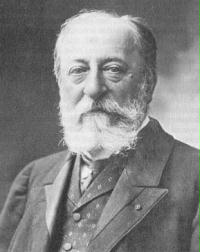Camille Saint-Saëns
Charles Camille Saint- Saëns [' ʃaʁl ka'mij sɛ'sɑ ] ( born October 9, 1835 in Paris, † December 16, 1921 in Algiers ) was a French pianist, organist, musicologist, music educator and composer of the Romantic period. He was known primarily for his "great zoological fantasy " Carnival of the Animals and the opera Samson et Dalila.
- 2.1 Works for Piano
- 2.2 Works for Organ
- 2.3 Works for Violin
- 2.4 Works for Cello
- 2.5 works for other solo instruments
- 2.6 Chamber Music
- 2.7 works for orchestra
- 2.8 Operas and Ballet
- 2.9 Sacred Works
Life
Training
Camille Saint- Saëns ' musical talent was encouraged early on by his mother and great-aunt. With 3 years he could read at the age of six, he wrote his first compositions, with eleven years he gave his first public concert in 1846 at the Salle Pleyel in Paris. By some contemporaries he was traded as the new Mozart. At 16 he was already a student at the University of Paris, at age 15 he had previously composed the Symphony in A major.
At the Paris Conservatory, he studied piano with Camille Stamaty, organ with François Benoist, and Fromental Halévy composition with Jacques. In 1852 he became organist of Saint- Séverin in Paris. In this year he met Franz Liszt know who should also musically have a lasting influence on him.
Early work
His musical debut as a composer, he had in 1853 when his first symphony was performed, and in 1857 with his second, which were well received by critics.
In 1854, he joined the Église Saint -Merry, 1858 at the Madeleine Church, was in 1877 but to this position in order to devote himself to composition. From 1861 to 1865 he taught at the École Niedermeyer de Paris piano, where Gabriel Fauré was one of his students.
Influenced by theater originated in 1865 the operas Le Timbre d' Argent and 1868 Samson and Delilah, who were equally as Etienne Marcel little success. In 1872 he composed the almost unknown opera The Yellow Princess. It was not until 1877 Samson and Delilah was first performed in Weimar and Lyon, in Paris, the French premiere took place in 1892.
He had with his symphonic poems Le Rouet d' Omphale (1872 ), Phaeton (1873 ), Danse macabre (1875 ), in which he introduced the xylophone in the symphonic music much more success, and La Jeunesse d' Hercule (1877 ). The 1858 completed Oratorio de Noël op 12 enjoys great popularity for several years and will increasingly use as an alternative to Johann Sebastian Bach's Christmas Oratorio place in the Christmas church music.
After the Franco-German war he made in 1871 for a national French music strong and founded with César Franck, the Société Nationale de Musique. In the following years he made numerous concert tours and worked not only as a composer and pianist, but also essays on musical topics.
Late work
Long remained a bachelor, he married in 1875 at age 40, the 19 -year-old industrialist 's daughter Marie -Laure Truffot from Le Cateau- Cambrésis. The marriage was unhappy. Two sons died in 1878. Saint- Saëns left his wife, leaving a piece of paper "I 'm gone " and moved back to his mother. In 1877, he received 100,000 francs from a patron Albert Libon, which he dedicated in 1878 Requiem. In the 1880s, he was considered the greatest musicians of the country, was in 1881 elected to the Academy of Fine Arts in 1884 and an Officer of the Legion of Honor, 1913, he received the Grand Cross of the Legion of Honour. In his last years, he traveled extensively in North Africa and America, even at 80 years old he made a successful tour of the USA. He fought influences of German music on the French and especially the cult of Richard Wagner and Arnold Schoenberg. With 86 years he played in the casino of Dieppe on the 75th stage anniversary as a pianist.
Nevertheless, his fame faded in France, where he was regarded as old-fashioned. Although he had advocated a progressive French symphonic music, his music remained more conservative. The major exception is his late work Le Carnaval des Animaux is ( Carnival of the Animals ) of 1886, which stood out by its descriptive character of contemporary music. In 1908, he composed for the first time a special soundtrack for the film The Assassination of the Duke of Guise.
Among his famous compositions include the Symphony No. 3 in C minor, the Organ Symphony, which was world-wide appeal and the Dies Irae to the basic theme has. The significant Maestoso of the work inspired the duo Scott Fitzgerald and Yvonne Keeley to the reggae adaptation of If I Had Words, which in 1978 became a chart success. Some of the piano concertos (especially the second, fourth and fifth) are still one of his more famous creations, his first Cello Concerto in A minor is considered duty of every solo cellist.
Its instrumentation is sometimes marked by peculiar, almost experimental sounds. So he prescribes for example, in the said Organ Symphony a piano part, 4 hands in the final movement, in his Piano Quintet, he also demanded in the final movement the use of a double bass.
After the death in Algiers on a trip he was transferred to Paris and he was buried at the Montparnasse Cemetery.
Overview of his work
Works for Piano
- 6 Bagatelles, Op 3
- Mazurka op 21
- Gavotte op.23
- Mazurka op 24
- Allegro, Op 29
- 6 Etudes op 52
- Minuet and waltz op 56
- Une nuit a Lisbonne op 63
- Mazurka op 66
- Allegro appassionato, Op 70
- Album for Piano, Op 72
- Souvenir d'Italie, Op 80
- Le cloches du soir, Op 85
- Valse op 88 canariote
- Suite for Piano, Op 90
- Duettino op 11
- Feuillet d' album, Op 81
- Pas redouble op 86
- Berceuse, Op 105
- Marche interaliée op 155
- Beethoven 's Variations Op 35
- King Harald Harfagar
- Minuet et Gavotte, Op 65
- Polonaise for 2 pianos, Op 77
- Scherzo for two pianos, Op 87
- Caprice Arabe op 96
- Caprice héroique op 106
- Sur les bords du Nil, Op 125
- Piano Concerto No. 1 in D major, Op 17 (1858 )
- Piano Concerto No. 2 in G minor, Op 22 (1868 )
- Piano Concerto No. 3 in E flat major, Op 29 (1869 )
- Piano Concerto No. 4 in C minor, Op 44 (1875 )
- Piano Concerto No. 5 in F major, Op 103 "Egyptian Concert" (1896 )
- Allegro appassionato, Op 70
- Rhapsodie d' Auvergne, Op 73
- Weddingcake Op 76 (string orchestra only )
- Africa, Op 89
Works for Organ
- Rhapsodies on Breton melodies Op 7
- Préludes et Fugues, Op 99
- Elévation ou Communion, Op 13
- 1 Fantasia for organ in E flat major (without opus number )
- 2 Fantasia for organ in D flat major, Op 101
- Improvisations, Op 150
- 3 Fantasia for organ in C major Op.157
- Neuf Pièces pour Orgue ou Harmonium ( L' Organiste 1912)
- 3 Morceaux pour Harmonium
- Six Duos pour Harmonium et Piano, Op 8
Works for Violin
- Violin Sonata No. 1 in D minor, Op 75
- Violin Sonata No. 2, Op 102
- Berceuse, Op 38
- Triptychs, Op 136
- Elegie, Op 143
- Elegie, Op 160
- Violin Concerto No. 1 in A major, Op 20 (1859 )
- Violin Concerto No. 2 in C major, Op 58 (1880 )
- Violin Concerto No. 3 in B minor, Opus 61 (1880 )
- Introduction et Rondo Capriccioso, Op 28
- Romance in C major op 48
- Romance Op 51
- Morceau de concert op 62
- Havanaise op.83 (1887 )
- Sarabande No. 1 in E - flat major, Op 93
- Caprice Andalou, Op 122 (1904)
Works for Cello
- Cello Sonata No. 1 in C minor, Op 32 (1872 )
- Chant saphique op 91 (1887 )
- Cello Sonata No. 2 in F major, Opus 123 ( 1905)
- Souvenirs ( 1895)
- The Swan (from Carnival of the Animals )
- Cello Concerto No. 1 in A minor, Op 33 (1872 )
- Concerto for Cello No. 2 in D minor, Op 119
- Suite for Cello and Orchestra, Op 16 (1863 )
- Allegro appassionato, Op 43 (1876 )
Works for other solo instruments
- Romance in D flat major, Op 37
- Odelette op 162
- Romance for Horn and Piano, Op 67
- Romance in F major, Op 36
- Morceau de concert op 94
- Cavatina for tenor trombone and piano op 114
- Cypres et Laurier for Organ and Orchestra
- Harp Concerto, Op 154
- Prière [ prayer ] for cello and organ, Op 158
- Sonata for Oboe and Piano, Op 166
- Sonata for Clarinet and Piano, Op 167
- Sonata for Bassoon and Piano, Op 168
Chamber Music
- String Quartet No. 1, Op 112
- String Quartet No. 2, Op 153
- Piano Trio No. 1, Op 18
- Piano Trio No. 2, Op 92
- Piano Quartet Op 41
- Piano Quintet, Op 14
- Tarantella for Flute, Clarinet and Piano, Op 6
- Septet in E flat major for Trumpet, Two Violins, Viola, Cello, Double Bass and Piano, Op 65
- Caprice sur airs of danois et russes for flute, oboe, clarinet and piano, Op 79
- Fantasy for Violin and Harp, Op 124
- Sonata for Clarinet and Piano in E flat major, Op 167
Works for Orchestra
- Symphony in A major ( 1850)
- Symphony No. 1 in E flat major, Op 2 (1853 )
- Symphony in F major, " Urbs Roma " (1856 )
- Symphony No. 2 in A minor, Op 55 (1859 )
- Symphony No. 3 in C minor, Op 78 " Organ Symphony " (1886 )
- Le Rouet d' Omphale, Op 31 (1872 )
- Phaeton, Op 39 (1873 )
- Danse macabre, Op 40 (1874 )
- Algérienne Suite Op 60
- Wedding Cake, Op 76
- L' Assassinat de duc de Guise, Op 128 (film music)
- La muse et le poète Op 132 (1909)
- La Jeunesse d' Hercule (1877 )
- Le Carnaval des Animaux (1886 )
- Trois Tableaux d' apres La Foi Synphoniques op 130 ( Drame de Brieux )
- Orient et Occident, Op 25 (1869 )
Opera and Ballet
- Fredegonde
- Etienne Marcel
- Henry VIII
- Le Timbre d' Argent (1865 )
- La princesse jaune (1872 )
- Samson et Dalila (1877 )
- Les Barbares (1901 )
- Hélène (1903 )
- Javotte (1896 )
Sacred Works
- Mass op 4
- Oratorio de Noël op 12 (1858 )
- Psalm XVII, Op 42
- Le Déluge op 45
- Requiem op 54









